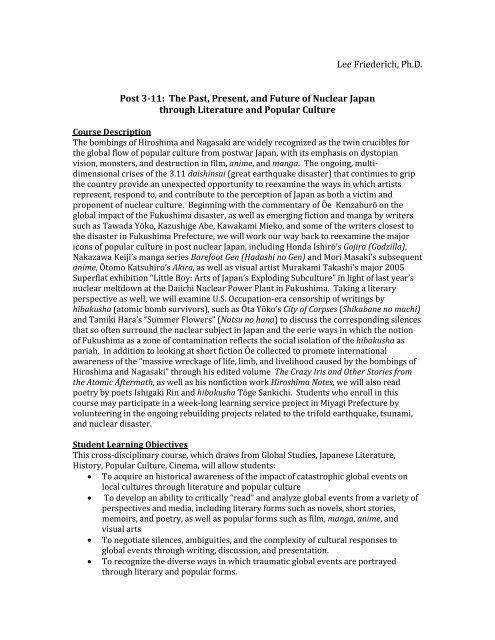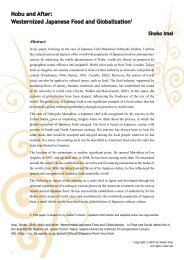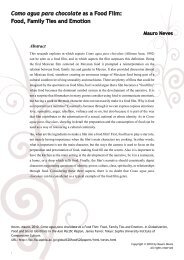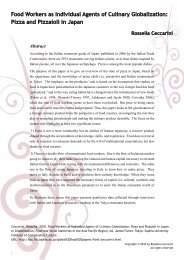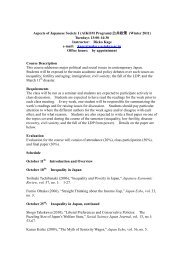Post 3-11: The Past, Present, and Future of Nuclear Japan(pdf)
Post 3-11: The Past, Present, and Future of Nuclear Japan(pdf)
Post 3-11: The Past, Present, and Future of Nuclear Japan(pdf)
Create successful ePaper yourself
Turn your PDF publications into a flip-book with our unique Google optimized e-Paper software.
Lee Friederich, Ph.D.<br />
<strong>Post</strong> 3-<strong>11</strong>: <strong>The</strong> <strong>Past</strong>, <strong>Present</strong>, <strong>and</strong> <strong>Future</strong> <strong>of</strong> <strong>Nuclear</strong> <strong>Japan</strong><br />
through Literature <strong>and</strong> Popular Culture<br />
Course Description<br />
<strong>The</strong> bombings <strong>of</strong> Hiroshima <strong>and</strong> Nagasaki are widely recognized as the twin crucibles for<br />
the global flow <strong>of</strong> popular culture from postwar <strong>Japan</strong>, with its emphasis on dystopian<br />
vision, monsters, <strong>and</strong> destruction in film, anime, <strong>and</strong> manga. <strong>The</strong> ongoing, multidimensional<br />
crises <strong>of</strong> the 3.<strong>11</strong> daishinsai (great earthquake disaster) that continues to grip<br />
the country provide an unexpected opportunity to reexamine the ways in which artists<br />
represent, respond to, <strong>and</strong> contribute to the perception <strong>of</strong> <strong>Japan</strong> as both a victim <strong>and</strong><br />
proponent <strong>of</strong> nuclear culture. Beginning with the commentary <strong>of</strong> Ōe Kenzaburō on the<br />
global impact <strong>of</strong> the Fukushima disaster, as well as emerging fiction <strong>and</strong> manga by writers<br />
such as Tawada Yōko, Kazushige Abe, Kawakami Mieko, <strong>and</strong> some <strong>of</strong> the writers closest to<br />
the disaster in Fukushima Prefecture, we will work our way back to reexamine the major<br />
icons <strong>of</strong> popular culture in post nuclear <strong>Japan</strong>, including Honda Ishirō’s Gojira (Godzilla),<br />
Nakazawa Keiji’s manga series Barefoot Gen (Hadashi no Gen) <strong>and</strong> Mori Masaki’s subsequent<br />
anime, Ōtomo Katsuhiro’s Akira, as well as visual artist Murakami Takashi’s major 2005<br />
Superflat exhibition “Little Boy: Arts <strong>of</strong> <strong>Japan</strong>’s Exploding Subculture” in light <strong>of</strong> last year’s<br />
nuclear meltdown at the Daiichi <strong>Nuclear</strong> Power Plant in Fukushima. Taking a literary<br />
perspective as well, we will examine U.S. Occupation-era censorship <strong>of</strong> writings by<br />
hibakusha (atomic bomb survivors), such as Ōta Yōko’s City <strong>of</strong> Corpses (Shikabane no machi)<br />
<strong>and</strong> Tamiki Hara’s “Summer Flowers” (Natsu no hana) to discuss the corresponding silences<br />
that so <strong>of</strong>ten surround the nuclear subject in <strong>Japan</strong> <strong>and</strong> the eerie ways in which the notion<br />
<strong>of</strong> Fukushima as a zone <strong>of</strong> contamination reflects the social isolation <strong>of</strong> the hibakusha as<br />
pariah. In addition to looking at short fiction Ōe collected to promote international<br />
awareness <strong>of</strong> the “massive wreckage <strong>of</strong> life, limb, <strong>and</strong> livelihood caused by the bombings <strong>of</strong><br />
Hiroshima <strong>and</strong> Nagasaki” through his edited volume <strong>The</strong> Crazy Iris <strong>and</strong> Other Stories from<br />
the Atomic Aftermath, as well as his nonfiction work Hiroshima Notes, we will also read<br />
poetry by poets Ishigaki Rin <strong>and</strong> hibakusha Tōge Sankichi. Students who enroll in this<br />
course may participate in a week-long learning service project in Miyagi Prefecture by<br />
volunteering in the ongoing rebuilding projects related to the trifold earthquake, tsunami,<br />
<strong>and</strong> nuclear disaster.<br />
Student Learning Objectives<br />
This cross-disciplinary course, which draws from Global Studies, <strong>Japan</strong>ese Literature,<br />
History, Popular Culture, Cinema, will allow students:<br />
To acquire an historical awareness <strong>of</strong> the impact <strong>of</strong> catastrophic global events on<br />
local cultures through literature <strong>and</strong> popular culture<br />
To develop an ability to critically “read” <strong>and</strong> analyze global events from a variety <strong>of</strong><br />
perspectives <strong>and</strong> media, including literary forms such as novels, short stories,<br />
memoirs, <strong>and</strong> poetry, as well as popular forms such as film, manga, anime, <strong>and</strong><br />
visual arts<br />
To negotiate silences, ambiguities, <strong>and</strong> the complexity <strong>of</strong> cultural responses to<br />
global events through writing, discussion, <strong>and</strong> presentation.<br />
To recognize the diverse ways in which traumatic global events are portrayed<br />
through literary <strong>and</strong> popular forms.
To gain a personal perception <strong>of</strong> global events by participating in international<br />
teamwork <strong>and</strong> service by volunteering through an NPO to help rebuild in the<br />
tsunami-stricken area <strong>of</strong> Miyagi Prefecture on the east coast <strong>of</strong> <strong>Japan</strong>. (This segment<br />
<strong>of</strong> the course is not m<strong>and</strong>atory.)<br />
Texts for this Course<br />
Hiroshima: Three Witnesses, edited by Earl Minear<br />
Barefoot Gen, Vol. 1: A Cartoon Story <strong>of</strong> Hiroshima by Nakazawa Keiji<br />
Black Rain, Ibuse Masuji<br />
March was Made <strong>of</strong> Yarn: Reflections on the <strong>Japan</strong>ese Earthquake Tsunami, <strong>and</strong> <strong>Nuclear</strong><br />
Meltdown, edited by Elmer Luke <strong>and</strong> David Karashima<br />
Additional short readings provided by instructor<br />
Major Assignments <strong>and</strong> Projects<br />
Tuesday In-class Writing: Each Tuesday, students will do a brief in-class writing<br />
assignment that will be used as a springboard into both small <strong>and</strong> large group<br />
discussion about the day’s reading assignment.<br />
Thursday Journals: Students will write a two-page journal entry in advance <strong>of</strong> class<br />
each Thursday responding to the reading that will be discussed on that day.<br />
Formal Writing Assignments: Students will be given 2 formal writing assignments<br />
over the course <strong>of</strong> the semester dealing with the texts that we explore in this course<br />
(including manga, film, <strong>and</strong> anime). Depending on the level <strong>of</strong> the course,<br />
assignments will lead students to integrate outside research into both papers, to<br />
enhance their underst<strong>and</strong>ing <strong>of</strong> the topics that they choose to investigate further.<br />
Learning Service Journal <strong>and</strong> <strong>Present</strong>ation: Each student who participates in the<br />
learning service project will be responsible for keeping an on-line journal each<br />
evening detailing his or her experience there. <strong>The</strong>se students will collaborate in a<br />
public presentation <strong>of</strong> their experience in <strong>Japan</strong>. Students who do not go to<br />
Ishinomaki will write written responses to the on-line journal as it is being<br />
produced, participate as audience members at the forum, <strong>and</strong> work together to do a<br />
critical evaluation <strong>of</strong> the forum.<br />
Semester Units <strong>and</strong> Reading Assignments<br />
Week 1 (Jan. 29-Jan. 31)<br />
On the Ground in <strong>Japan</strong> Today: An Introduction<br />
1. “Radioactive Rain <strong>and</strong> the American Umbrella,” <strong>The</strong> Journal <strong>of</strong> Asian Studies,<br />
May 2012<br />
2. “<strong>The</strong> Ongoing Disaster” by Alexis Dudden, <strong>The</strong> Journal <strong>of</strong> Asian Studies, May<br />
2012<br />
3. “History Repeats” by Ōe Kenzaburō, <strong>The</strong> New Yorker, March 28, 20<strong>11</strong>.<br />
Weeks 2-3 (February 5-14)<br />
3.<strong>11</strong> <strong>and</strong> the Writer as Activist<br />
1. “<strong>The</strong> Isl<strong>and</strong> <strong>of</strong> Eternal Life” by Tawada Yōko (pages 3-13), “Nightcap” by<br />
Ogawa Yoko (pages 35-36) <strong>and</strong> “March Yarn” by Kawakami Mieko (pages<br />
55-69)<br />
2. “Ride on Time” by Abe Kazushige (pages 183-88), “Crows <strong>and</strong> the Girl” by<br />
Brother <strong>and</strong> Sister Nishioka (manga)<br />
3. “<strong>The</strong> Charm” by Shigematsu Kiyoshi (13-33)<br />
4. “Snow Dusk, Death Dusk,” by Yoshikawa Yasuhisa
Weeks 4-5 (Feb 19-28)<br />
Censorship <strong>and</strong> other silences surrounding Hibakusha Literature with readings from<br />
Hiroshima: Three Witnesses:<br />
1. “Introduction to Hiroshima: Three Witnesses” by Earl Minear (pages 3-18)<br />
<strong>and</strong> “Summer Flowers” by Tamiki Hara (pages 45-60)<br />
2. “A City <strong>of</strong> Corpses” by Ōta Yōko (pages 147-178)<br />
3. Poems <strong>of</strong> the Atomic Bomb by Tōge Sankichi (pages 305-338)<br />
Week 6-7 (Mar 5-14)<br />
<strong>The</strong> Monster Within: Godzilla (<strong>Japan</strong>ese <strong>and</strong> American versions)—films to be viewed before<br />
class<br />
1. Gojira (the original <strong>Japan</strong>ese version), 1954 (view by Feb 12)<br />
2. Godzilla, King <strong>of</strong> the Monsters (American spin<strong>of</strong>f), 1956 (view by Feb 19)<br />
3. Review <strong>of</strong> Godzilla on My Mind: Fifty Years <strong>of</strong> the King <strong>of</strong> Monsters by William<br />
Tsutsui, Journal <strong>of</strong> <strong>Japan</strong>ese Studies, 2006<br />
Week 8 (Spring Break, Mar 17-24)<br />
Service Learning Project in the Tsunami Zone <strong>of</strong> Miyagi Prefecture (contingent<br />
on grant funds<br />
Week 9 (March 26-28)<br />
Victim’s Ideology <strong>and</strong> Barefoot Gen—manga <strong>and</strong> anime (to be viewed before class)<br />
1. Barefoot Gen, Volume 1, manga by Keiji Nakazawa<br />
2. Barefoot Gen, anime by Masaki Mori (film to be viewed before class)<br />
Week 10 (April 2-4)<br />
<strong>Post</strong> <strong>Nuclear</strong> Writers: Ōe Kenzaburō <strong>and</strong> Ibuse Masuji<br />
1. Hiroshima Notes by Ōe Kenzaburō (pages 7-56)<br />
2. Introduction to <strong>The</strong> Crazy Iris, “Toward the Unknowable <strong>Future</strong>” by Ōe<br />
Kenzaburō <strong>and</strong> “<strong>The</strong> Crazy Iris” by Ibuse Masuji (9-35)<br />
Weeks <strong>11</strong>-12 (April 9-18)<br />
Black Rain by Ibuse Masuji (pages 5-300)<br />
Week 13 (April 23-April 25)<br />
Super Flat <strong>and</strong> Little Boy: Arts <strong>of</strong> <strong>Japan</strong>’s Exploding Subculture<br />
1. Selections from Super Flat <strong>and</strong> Little Boy<br />
Week 14 (April 30-May 2)<br />
<strong>Post</strong>war Apocalyptic Vision<br />
1. Akira (view anime before class)


